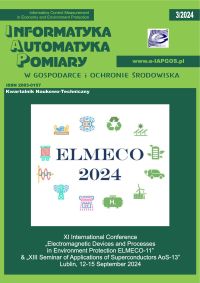ZASTOSOWANIE UCZENIA MASZYNOWEGO NA CZUJNIKACH SMARTFONÓW DO WYKRYWANIA UPADKÓW W CZASIE RZECZYWISTYM
Achraf Benba
achraf.benba@um5s.net.maMohammed V University in Rabat, Ecole Nationale Supérieure d'Arts et Métiers, Electronic Systems Sensors and Nanobiotechnologies (Maroko)
https://orcid.org/0000-0001-7939-0790
Mouna Akki
Mohammed V University in Rabat, Ecole Nationale Supérieure d'Arts et Métiers, Electronic Systems Sensors and Nanobiotechnologies (Maroko)
http://orcid.org/0009-0001-8532-1158
Sara Sandabad
Hassan II University of Casablanca, Ecole Normale Supérieure de l'Enseignement Technique de Mohammadia, Electrical Engineering and Intelligent Systems (Maroko)
http://orcid.org/0000-0002-0813-6178
Abstrakt
Wraz z rosnącą popularnością smartfonów są one wyposażone w wiele czujników, takich jak GPS, mikrofony, kamery, magnetometry, akceleratory i inne, które mogą uprościć nasze codzienne życie. Jeśli chodzi o opiekę zdrowotną, smartfony mogą stać się niezastąpione. Wykrywanie upadków geriatrycznych ma kluczowe znaczenie, ponieważ nawet najmniejszy uraz może mieć śmiertelne konsekwencje. Dlatego zaproponowano wykorzystanie w naszych badaniach akcelerometrów do wykrywania upadków osób starszych. Nasz projekt polegał na opracowaniu zautomatyzowanego, ciągłego i niezawodnego systemu monitoringu, który generowałby listę osób starszych zagrożonych upadkiem i prezentował ją na stronie internetowej służb ratowniczych. Podejście to miało na celu zminimalizowanie długoterminowych skutków i szybkie ratowanie życia. Rozpoczęto od opracowania aplikacji mobilnej i za pomocą MATLABa sklasyfikowano upadki jako „upadek” lub „nie upadek”. Ostatecznie stworzono stronę internetową, która ułatwiłaby komunikację między aplikacją mobilną a MATLABem.
Słowa kluczowe:
detekcja upadku, akcelerometry smartfonów, SVM, KNN, uczenie maszynoweBibliografia
Bouilly M., Thélot B.: Les accidents de la vie courante aux urgences en France métropolitaine en 2010 selon l’enquête EPAC. Revue d'Épidémiologie et de Santé Publique 60, 2012, S145.
DOI: https://doi.org/10.1016/j.respe.2012.06.382
Google Scholar
Cherkassky V., Ma Y.: Practical selection of SVM parameters and noise estimation for SVM regression. Neural networks 17(1), 2004, 113–126 [http://doi.org/10.1016/S0893-6080(03)00169-2].
DOI: https://doi.org/10.1016/S0893-6080(03)00169-2
Google Scholar
El Attaoui A. et al.: Machine learning‐based edge‐computing on a multi‐level architecture of WSN and IoT for real‐time fall detection. IET Wireless Sensor Systems 10(6), 2020, 320–332 [http://doi.org/10.1049/iet-wss.2020.0091].
DOI: https://doi.org/10.1049/iet-wss.2020.0091
Google Scholar
Enterprise J.: HTML, PHP, dan MySQL untuk Pemula. Elex Media Komputindo 2018.
Google Scholar
Er P. V., Tan K. K.: Non-intrusive fall detection monitoring for the elderly based on fuzzy logic. Measurement 124, 2018, 91–102 [http://doi.org/10.1016/j.measurement.2018.04.009].
DOI: https://doi.org/10.1016/j.measurement.2018.04.009
Google Scholar
Fukunaga K.: Introduction to statistical pattern recognition. Elsevier 2013.
Google Scholar
Guo G. et al.: KNN model-based approach in classification. Lecture Notes in Computer Science 2888, 2003 [http://doi.org/10.1007/978-3-540-39964-3_62].
DOI: https://doi.org/10.1007/978-3-540-39964-3_62
Google Scholar
James K.: Falls and Fall Prevention in the Elderly. West Indian Med J. 56(6), 2007, 534.
Google Scholar
Le H. L. et al.: A novel feature set extraction based on accelerometer sensor data for improving the fall detection system. Electronics 11(7), 2022, 1030 [http://doi.org/10.3390/electronics11071030].
DOI: https://doi.org/10.3390/electronics11071030
Google Scholar
Li D., Wu M.: Pattern recognition receptors in health and diseases. Signal transduction and targeted therapy 6(1), 2021, 291 [http://doi.org/10.1038/s41392-021-00687-0].
DOI: https://doi.org/10.1038/s41392-021-00687-0
Google Scholar
Noury N. et al.: Fall detection-principles and methods. 29th annual international conference of the IEEE engineering in medicine and biology society, 2007, 1663–1666 [http://doi.org/10.1109/IEMBS.2007.4352627].
DOI: https://doi.org/10.1109/IEMBS.2007.4352627
Google Scholar
Pannurat N. et al.: Automatic fall monitoring: A review. Sensors 14(7), 2014, 12900–12936 [http://doi.org/10.3390/s140712900].
DOI: https://doi.org/10.3390/s140712900
Google Scholar
Patton E. W.: MIT app inventor: Objectives, design, and development. Computational thinking education, 2019, 31–49 [http://doi.org/10.1007/978-981-13-6528-7].
DOI: https://doi.org/10.1007/978-981-13-6528-7_3
Google Scholar
Rashid F. A.: Simulation of SisFall Dataset for Fall Detection Using MATLAB Classifier Algorithms. 12th International Symposium on Parallel Architectures, Algorithms and Programming – PAAP, 2021, 62–68, [http://doi.org/10.1109/PAAP54281.2021.9720481].
DOI: https://doi.org/10.1109/PAAP54281.2021.9720481
Google Scholar
Sucerquia A. et al.: SisFall: A fall and movement dataset. Sensors 17(1), 2017, 198 [http://doi.org/10.3390/s17010198].
DOI: https://doi.org/10.3390/s17010198
Google Scholar
World Health Organization: Ageing, Life Course Unit. WHO global report on falls prevention in older age. World Health Organization; 2008.
Google Scholar
Zhang S. et al.: Learning k for kNN classification. ACM Transactions on Intelligent Systems and Technology 8(3), 2017, 1–9 [http://doi.org/10.1145/2990508].
DOI: https://doi.org/10.1145/2990508
Google Scholar
Autorzy
Achraf Benbaachraf.benba@um5s.net.ma
Mohammed V University in Rabat, Ecole Nationale Supérieure d'Arts et Métiers, Electronic Systems Sensors and Nanobiotechnologies Maroko
https://orcid.org/0000-0001-7939-0790
Autorzy
Mouna AkkiMohammed V University in Rabat, Ecole Nationale Supérieure d'Arts et Métiers, Electronic Systems Sensors and Nanobiotechnologies Maroko
http://orcid.org/0009-0001-8532-1158
Autorzy
Sara SandabadHassan II University of Casablanca, Ecole Normale Supérieure de l'Enseignement Technique de Mohammadia, Electrical Engineering and Intelligent Systems Maroko
http://orcid.org/0000-0002-0813-6178
Statystyki
Abstract views: 129PDF downloads: 143
Licencja

Utwór dostępny jest na licencji Creative Commons Uznanie autorstwa – Na tych samych warunkach 4.0 Miedzynarodowe.
Inne teksty tego samego autora
- Achraf Benba, Abdelilah Kerchaoui, AUTOMATYCZNE WYKRYWANIE CHOROBY ALZHEIMERA W OPARCIU O SZTUCZNĄ INTELIGENCJĘ , Informatyka, Automatyka, Pomiary w Gospodarce i Ochronie Środowiska: Tom 13 Nr 1 (2023)
- Achraf Benba, Fatima Zahra El Attaoui, Sara Sandabad, WDROŻENIE SYSTEMU POZYSKIWANIA EKG OPARTEGO NA SZTUCZNEJ INTELIGENCJI W CELU WYKRYWANIA NIEPRAWIDŁOWOŚCI SERCA , Informatyka, Automatyka, Pomiary w Gospodarce i Ochronie Środowiska: Tom 13 Nr 1 (2023)
- Oumaima Majdoubi, Achraf Benba, Ahmed Hammouch, KLASYFIKACJA CHOROBY PARKINSONA I INNYCH ZABURZEŃ NEUROLOGICZNYCH Z WYKORZYSTANIEM EKSTRAKCJI CECH GŁOSOWYCH I TECHNIK REDUKCJI , Informatyka, Automatyka, Pomiary w Gospodarce i Ochronie Środowiska: Tom 13 Nr 3 (2023)
- Oumaima Majdoubi, Achraf Benba, Ahmed Hammouch, KOMPLEKSOWE METODY UCZENIA MASZYNOWEGO I UCZENIA GŁĘBOKIEGO DO KLASYFIKACJI CHOROBY PARKINSONA I OCENY JEJ NASILENIA , Informatyka, Automatyka, Pomiary w Gospodarce i Ochronie Środowiska: Tom 13 Nr 4 (2023)








